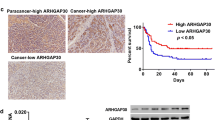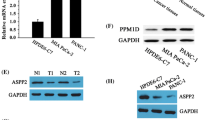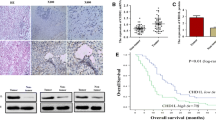Abstract
Anti-silencing function 1B (ASF1B) has been reported to be associated with the occurrence of many kinds of tumors. However, the biological effect and action mechanism of ASF1B in pancreatic cancer (PC) tumorigenesis remain unclear. The expression and prognosis value of ASF1B in PC were analyzed using GEPIA, GEO, and Kaplan–Meier plotter databases. The diagnostic value of ASF1B in PC was determined by receiver operating characteristic curve. The relationship between ASF1B expression and the clinical feathers in PC was investigated based on TCGA. qRT-PCR and western blot analyses were used to measure ASF1B expression in PC cells. Cell proliferation was evaluated by MTT and EdU assays, and apoptosis was examined by TUNEL and caspase-3 activity assays. Western blot analysis was utilized to detect the expression of proliferating cell nuclear antigen (PCNA), cyclin D1, Bax, Bcl-2, and phosphatidylinositol 3-kinase (PI3K)/protein kinase B (Akt) signaling proteins. ASF1B was overexpressed in several digestive cancers, including PC. Upregulated ASF1B was correlated with the poor prognosis and clinical features in PC patients. The area under the curve (AUC) value of ASF1B was 0.990. ASF1B was also overexpressed in PC cells. ASF1B silencing inhibited PC cell proliferation, promoted apoptosis, and increased caspase-3 activity, which were accompanied by the reduction of PCNA and cyclin D1 expression and increase of the ratio of Bax/Bcl-2 expression. Additionally, ASF1B silencing suppressed the PI3K/Akt pathway and 740Y-P treatment partially abolished the effects of ASF1B knockdown on PC cells. In conclusion, ASF1B silencing retarded proliferation and promoted apoptosis in PC cells by inactivation of the PI3K/Akt pathway.







Similar content being viewed by others
Data availability
The experimental data will be available on the request.
Code availability
Not applicable.
References
Park W, Chawla A, O’Reilly EM (2021) Pancreatic cancer: a review. JAMA 326(9):851–862
Siegel RL, Miller KD,Fuchs HE, Jemal A (2021) Cancer statistics. CA Cancer J Clin 71(1):7–33
Paulson AS, Tran Cao HS, Tempero MA, Lowy AM (2013) Therapeutic advances in pancreatic cancer. Gastroenterology 144(6):1316–1326
Wang ZM, Lu J, Zhang LY, Lin XZ, Chen KM, Chen ZJ et al (2015) Biological effects of low-dose-rate irradiation of pancreatic carcinoma cells in vitro using 125I seeds. World J Gastroenterol 21(8):2336–2342
Mohammed S, Van Buren G 2nd, Fisher WE (2014) Pancreatic cancer: advances in treatment. World J Gastroenterol 20(28):9354–9360
Falasca M (1865) Kim M and Casari I (2016) Pancreatic cancer: current research and future directions. Biochim Biophys Acta 2:123–132
Klompmaker S, de Rooij T, Korteweg JJ, van Dieren S, van Lienden KP, van Gulik TM et al (2016) Systematic review of outcomes after distal pancreatectomy with coeliac axis resection for locally advanced pancreatic cancer. Br J Surg 103(8):941–949
Lovecek M, Skalicky P, Chudacek J, Szkorupa M, Svebisova H, Lemstrova R et al (2017) Different clinical presentations of metachronous pulmonary metastases after resection of pancreatic ductal adenocarcinoma: Retrospective study and review of the literature. World J Gastroenterol 23(35):6420–6428
Gurard-Levin ZA, Quivy JP and Almouzni G (2014) Histone chaperones: assisting histone traffic and nucleosome dynamics. Annu Rev Biochem 83:487–517
Adkins MW, Howar SR, Tyler JK (2004) Chromatin disassembly mediated by the histone chaperone Asf1 is essential for transcriptional activation of the yeast PHO5 and PHO8 genes. Mol Cell 14(5):657–666
Munakata T, Adachi N, Yokoyama N, Kuzuhara T, Horikoshi M (2000) A human homologue of yeast anti-silencing factor has histone chaperone activity. Genes Cells 5(3):221–233
Messiaen S, Guiard J, Aigueperse C, Fliniaux I, Tourpin S, Barroca V et al (2016) Loss of the histone chaperone ASF1B reduces female reproductive capacity in mice. Reproduction 151(5):477–489
Seol JH, Song TY, Oh SE, Jo C, Choi A, Kim B et al (2015) Identification of small molecules that inhibit the histone chaperone Asf1 and its chromatin function. BMB Rep 48(12):685–690
Paul PK, Rabaglia ME, Wang CY, Stapleton DS, Leng N, Kendziorski C et al (2016) Histone chaperone ASF1B promotes human β-cell proliferation via recruitment of histone H3.3. Cell Cycle 15(23):3191–3202
Corpet A, De Koning L, Toedling J, Savignoni A, Berger F, Lemaître C et al (2011) Asf1b, the necessary Asf1 isoform for proliferation, is predictive of outcome in breast cancer. EMBO J 30(3):480–493
Rosty C, Sheffer M, Tsafrir D, Stransky N, Tsafrir I, Peter M et al (2005) Identification of a proliferation gene cluster associated with HPV E6/E7 expression level and viral DNA load in invasive cervical carcinoma. Oncogene 24(47):7094–7104
Tang Z, Li C, Kang B, Gao G, Li C, Zhang Z (2017) GEPIA: a web server for cancer and normal gene expression profiling and interactive analyses. Nucleic Acids Res 45(W1):W98-w102
Edgar R, Domrachev M, Lash AE (2002) Gene expression omnibus: NCBI gene expression and hybridization array data repository. Nucleic Acids Res 30(1):207–210
Asano T, Yao Y, Zhu J, Li D, Abbruzzese JL, Reddy SA (2004) The PI 3-kinase/Akt signaling pathway is activated due to aberrant Pten expression and targets transcription factors NF-kappaB and c-Myc in pancreatic cancer cells. Oncogene 23(53):8571–8580
Ng SSW, Tsao MS, Chow S, Hedley DW (2000) Inhibition of phosphatidylinositide 3-kinase enhances gemcitabine-induced apoptosis in human pancreatic cancer cells. Cancer Res 60(19):5451–5455
Bosetti C, Bertuccio P, Negri E, La Vecchia C, Zeegers MP, Boffetta P (2012) Pancreatic cancer: overview of descriptive epidemiology. Mol Carcinog 51(1):3–13
Ouaïssi M, Silvy F, Loncle C, Ferraz da Silva D, Martins Abreu C, Martinez E et al (2014) Further characterization of HDAC and SIRT gene expression patterns in pancreatic cancer and their relation to disease outcome. PLoS ONE 9(9):e108520
Hruban RH, Goggins M, Parsons J, Kern SE (2000) Progression model for pancreatic cancer. Clin Cancer Res 6(8):2969–2972
Avvakumov N, Nourani A, Côté J (2011) Histone chaperones: modulators of chromatin marks. Mol Cell 41(5):502–514
Han G, Zhang X, Liu P, Yu Q, Li Z, Yu Q et al (2018) Knockdown of anti-silencing function 1B histone chaperone induces cell apoptosis via repressing PI3K/Akt pathway in prostate cancer. Int J Oncol 53(5):2056–2066
Liu X, Song J, Zhang Y, Wang H, Sun H, Feng X et al (2020) ASF1B promotes cervical cancer progression through stabilization of CDK9. Cell Death Dis 11(8):705
Feng Z, Zhang J, Zheng Y, Wang Q, Min X, Tian T (2021) Elevated expression of ASF1B correlates with poor prognosis in human lung adenocarcinoma. Personal Med 18(2):115–127
Jiangqiao Z, Tao Q, Zhongbao C, Xiaoxiong M, Long Z, Jilin Z et al (2019) Anti-silencing function 1B histone chaperone promotes cell proliferation and migration via activation of the AKT pathway in clear cell renal cell carcinoma. Biochem Biophys Res Commun 511(1):165–172
Osaki M, Oshimura M, Ito H (2004) PI3K-Akt pathway: its functions and alterations in human cancer. Apoptosis 9(6):667–676
Liu S, Wang XJ, Liu Y, Cui YF (2013) PI3K/AKT/mTOR signaling is involved in (-)-epigallocatechin-3-gallate-induced apoptosis of human pancreatic carcinoma cells. Am J Chin Med 41(3):629–642
Fumarola C, Bonelli MA, Petronini PG, Alfieri RR (2014) Targeting PI3K/AKT/mTOR pathway in non small cell lung cancer. Biochem Pharmacol 90(3):197–207
Ocana A, Vera-Badillo F, Al-Mubarak M, Templeton AJ, Corrales-Sanchez V, Diez-Gonzalez L et al (2014) Activation of the PI3K/mTOR/AKT pathway and survival in solid tumors: systematic review and meta-analysis. PLoS ONE 9(4):e95219
Funding
None.
Author information
Authors and Affiliations
Contributions
KW, ZH, and XF conducted the experiments. XF, WL, and AJ supervised the data collection and analyzed the data. ZH and XH designed the study and prepared the manuscript. All authors have read and approved the manuscript.
Corresponding author
Ethics declarations
Conflict of interest
The authors declare no conflict of interest.
Consent to participate
Not applicable.
Consent for publication
All authors have approved for the publication of this manuscript.
Ethical approval
Not applicable.
Additional information
Publisher's Note
Springer Nature remains neutral with regard to jurisdictional claims in published maps and institutional affiliations.
Rights and permissions
About this article
Cite this article
Wang, K., Hao, Z., Fu, X. et al. Involvement of elevated ASF1B in the poor prognosis and tumorigenesis in pancreatic cancer. Mol Cell Biochem 477, 1947–1957 (2022). https://doi.org/10.1007/s11010-022-04404-5
Received:
Accepted:
Published:
Issue Date:
DOI: https://doi.org/10.1007/s11010-022-04404-5




